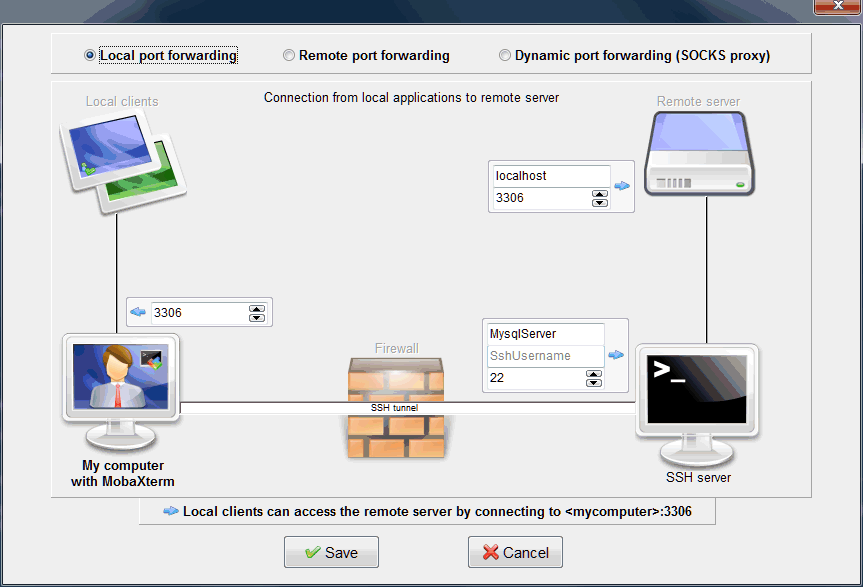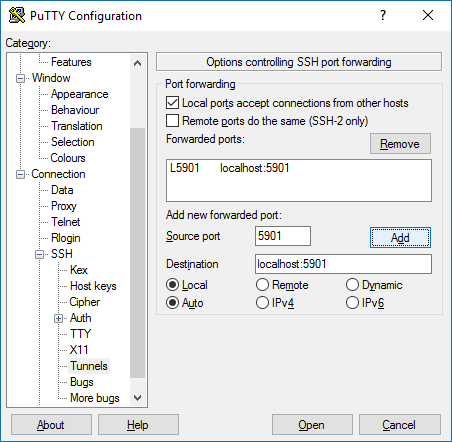

- TUNNEL PI VNC THROUGH SSH HOW TO
- TUNNEL PI VNC THROUGH SSH INSTALL
- TUNNEL PI VNC THROUGH SSH PRO
- TUNNEL PI VNC THROUGH SSH SOFTWARE
- TUNNEL PI VNC THROUGH SSH PASSWORD
I have a troubleshooting section over at the website linked above if you do come across any trouble. There are some issues you may come across but most of them are easily fixable. As I mentioned earlier there is basically a client available for almost every device so you shouldn’t have trouble setting up the remote desktop to the Raspberry Pi.

Installing the client onto your device is incredibly easy. The only real issue I had was getting it to launch automatically on boot up so the VNC server was accessible even if your pi had to restart. The overall installation process is actually pretty easy and you shouldn’t come across many problems. You might find this process will work on other Linux distributions. You will need to have Raspbian installed for your Raspberry Pi for this to work.
TUNNEL PI VNC THROUGH SSH SOFTWARE
This software is available for almost all modern operating systems.
TUNNEL PI VNC THROUGH SSH INSTALL
The Raspberry Pi remote desktop can be accessed from any device that is able to install and use a VNC viewer. For some people the command line interface is a little too daunting and prefer to just use the nice graphical user interface (GUI). Now you might be thinking isn’t that what SSH is for? Well this method allows you to view and use the GUI as if you were there at the Pi. Enjoy tunnelling VNC through SSH.In this video, I go through the steps of setting up a simple Raspberry Pi VNC server that will allow you to be able to access your Pi and use it from another computer. Not only is your VNC connection good to go, but it’s also more secure than if you had simply used the default VNC port. You should then be able to work on the remote desktop, using VNC, thanks to SSH. Once you click connect, your VNC client will use the encrypted SSH tunnel and make the connection between local and remote machines on port 5901. Why? Because we’ve created an SSH tunnel from localhost:5901 to REMOTE_IP:5901 (where REMOTE_IP is the IP address of the remote machine). Instead of entering, say, 192.168.1.83:5901 for the remote address, enter localhost:5901. What does matter, however, is the address you use to make the connection.
TUNNEL PI VNC THROUGH SSH HOW TO
( See: How to set up ssh key authentication.) Connecting your VNC Client Note: For an even more secure connection, I suggest you make use of SSH Key Authentication. Ssh -L 5901:localhost:5901 USER is the remote username and REMOTE_IP is the remote IP address. If you do not, you can always add the remote username like so: This will assume you have the same username on both local and remote machines. You will then be prompted for the remote user’s password. If you’ve never SSH’d to this remote host, you will be asked if you want to add the remote host to your local ~/.ssh/known_hosts file ( Figure A). Where REMOTE_IP is the IP address of the remote host. The first thing to do is create the tunnel that routes packets from localhost (at port 5901) to the remote host (at port 5901) through port 22. I will assume you already have everything you need installed, and your VNC server is running and accepting connections.

Remote machine: Openssh-server and a VNC server (such as TightVNC).

TUNNEL PI VNC THROUGH SSH PRO
SEE: Information security policy template download (Tech Pro Research) What you needĬhances are, you have everything you need already installed. If you don’t have access to the remote machine, through SSH, this won’t work. That, of course, means you must have access to the remote machine, via port 22. You will instruct SSH to create a local tunnel that forwards localhost on port 5901 to a remote machine’s port 5901, only through the default SSH port (22). With this handy networking tool, you can tunnel VNC through SSH, so not only are you not punching through the VNC port, but you’re sending all data through an encrypted tunnel. Security incident response: Critical steps for cyberattack recovery (TechRepublic Premium)įortunately, you have Secure Shell (SSH) to lean on.
TUNNEL PI VNC THROUGH SSH PASSWORD
The 10 best antivirus products you should consider for your businessĨ enterprise password managers and the companies that will love them But what happens when your company (or your home) network doesn’t allow the default VNC port (5901) to remain open? How do you get in? Must-read security coverage When that need arises, the most obvious choice of connection is VNC. There are times when you need to remote into a Linux desktop. If your network doesn't allow connections into the default VNC port 5901, you can tunnel it through SSH.


 0 kommentar(er)
0 kommentar(er)
